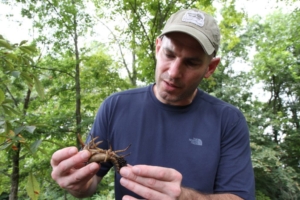Researchers at Virginia Tech are developing a computer model to track invertebrate behavior in mountain streams. Aquatic invertebrates like crayfish and mayflies are important because they are essential to food webs and are used as an indicator of freshwater health. Associate professor of biological sciences Bryan Brown hopes that the model will be used by land managers in a variety of ecosystems.

Bryan Brown inspecting a crayfish (VT)
He explained in a Virginia Tech news article that the model will be able to simulate the ecosystem response after disturbance events, like floods. This work, which was funded by an NSF grant, includes an analysis of past research and future field experiments with artificial streams. The team will compare invertebrate populations in different areas and they will induce disturbances and observe species’ responses.
The team has already found that headwaters are the most effective areas to restore because they are vulnerable to change but more likely to have stable invertebrate populations. They hope to build on this past research by simulating hundreds of species continuously and building a model that is responsive to a range of inputs, like temperature and rainfall.
The model could eventually be used across aquatic ecosystems, including in the Chesapeake Bay. Bryan said on this work, “I think a fantastic outcome for the future would be collaboration with anyone in the CB [Chesapeake Bay] area who would be interested in modifying the model to apply to aspects of the system.”
